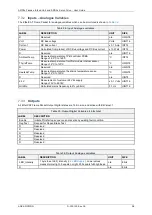
Control Wiring
ANCA Motion
D-000129 Rev 09
85
6
6.5
Motor Encoder Feedback
In the case where encoders are integrated into motors only those with internal reinforced insulation between
hazardous voltage in the motor and encoder signal circuits can be used with the AMD5x drive.
Analogue Encoder Interface signals
6.5.1
The AMD5x Drives have provision for two Analog Encoder Inputs. Refer
1 pin assignment, and
for Encoder 2 pin assignment.
The left hand Encoder 1 channel (X13) accepts Incremental 1 Vpp signals as well as 1 Vpp Commutation
(Comm) Track signals. The right hand Encoder 2 channel (X14) also accepts Incremental 1 Vpp signals, but does
not have a provision for Comm Track signals. Both Encoder 1 and Encoder 2 inputs convert Incremental signals
to QEP (“digital” version) signals for use by the AMD5x DSP QEP counters.
These incremental and Comm Track signal inputs are differential, with an input impedance of 120 Ohms for
incremental signals, and 1K Ohms for Comm Track signals. These inputs are tolerant of a range of offset
voltages of 1V to 3V, meaning that 3V3 based encoders (offset = 1.65V nom), and 5V encoders (offset = 2.5V
nom can be accommodated. Incremental 1 Vpp signals can have a frequency as high as 600kHz, and the
combination of encoder and axis speed should be selected to ensure that this frequency is never exceeded.
NOTE: Exceeding 600kHz on Incremental signals can result in poor sine and cosine quality and lost QEP counts,
which will cause defective operation.
Both Encoder 1 and Encoder 2 have Reference (index) signal inputs which are also differential, with an input
impedance of 120 Ohms which are nominally 1 Vpp, but in fact cover a wide range of Reference pulse formats.
The reference pulse detection circuitry essentially detects zero-crossing of the reference pulse input. The
reference pulse detection circuitry is compatible with various signal formats such as Renishaw and Tamagawa,
as well as the demanding Heidenhain Analogue Encoder.
Encoder cable connections are as per
3.7.4 X13
– Encoder 1 Input
for Encoder 1, and
3.7.5 X14
– Encoder 2
Input
for Encoder 2. It is recommended that the inner shield of a particular Encoder Cable be connected to
ENC1_0V or ENC2_0V or Pin 12. This cable inner shield should NOT make contact with the cable outer shield. It
is essential that the cable outer shield be connected to only the shell (casing) of the D-SUB connector.
NOTE: Poor or absent shielding connections is the main cause of noise problems within a system. The AMD5x
Drives are particularly robust, and have characteristically low noise in Encoder signal processing, but good
shielding is nevertheless essential in achieving this robustness.
Analogue Encoder Power Supplies
6.5.2
The AMD5x Drives provides a 5V DC supply to each of the Analog Encoders. Refer
for Encoder 1 pin assignment, and
for Encoder 2 pin assignment.
These supplies are independently regulated at the
“sending end” (the D-SUB connector on the Drive).
Regulation is particularly tight, and a voltage of 5.19V nominal is maintained at the respective D-SUB connector.
The maximum supply current per Encoder channel is 500mA, with the aggregate total from both channels not to
exceed 500mA. Under all variations of load and temperature, the regulation circuitry ensures that the sending
end voltage is between 5.10V and 5.25V.
Since cable compensation is not employed, care should be taken to ensure that cable volt-drop does not result in
under-voltage at the Encoder itself. For example, if a tight tolerance Encoder has an acceptable range of 4.75 to
5.25, then maximum total cable drop is 5.10 - 4.75 = 0.35V, at the particular current being drawn.
Each Encoder power supply is also short-circuit protected with solid state current limiting devices which are self-
resetting. The encoder power supply is monitored by the DSP and provides low voltage fault detection.






























